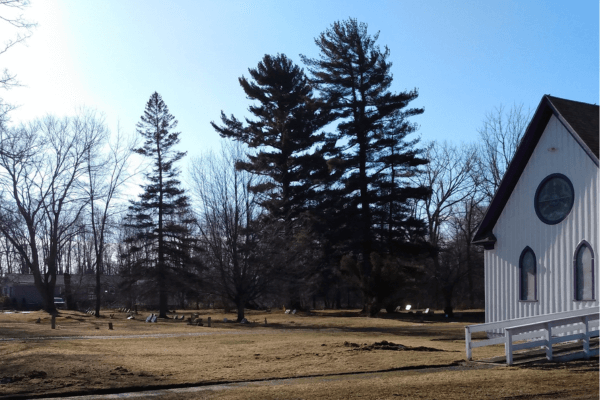Good Shepherd, Irving Identifying Unmarked Graves; Hosting Every Child Matters on September 30
For most of its 120-year history, the congregation at Church of the Good Shepherd has known that there are unmarked graves within and around their cemetery, which is the burial site of hundreds of Native American Episcopalians.
“There was simply a lack of funds for markers,” said the Rev. Roland Cooper, Good Shepherd’s priest.
Thanks in part to a grant from the diocesan partnership and a contribution from St. Paul’s Cathedral, Buffalo, work is underway to find, identify, and mark the currently unmarked graves—now thought to number about 70—that surround the building, which is located in Irving, New York in the Cattaraugus Territory of the Seneca Nation.
On Saturday, September 30 at 2 p.m., Good Shepherd will host Every Child Matters, a public event honoring Indigenous children who lost their lives and culture at residential schools across the United States and Canada. Planned as an attempt to “atone, apologize, and heal,” the event will include the prayer of Thanksgiving in both the Seneca language and English and the Great Litany. Seneca artist G. Peter Jemison and Bishop Sean will speak.
Those who attend are asked to wear the color orange in observance of Orange Shirt Day, an annual commemoration of the residential school experience and the healing journey of its survivors and their families.

“As Christians, we bear responsibility,” vestry member Rich Inserra said. “I’m praying that the Every Child Matters event is a time of healing. As we work together, we can better understand the past and reach toward the future.”
Visitors who attend Every Child Matters will have the opportunity to see the cemetery, which Inserra calls “a place of overlapping heritage.”
Good Shepherd’s leaders know that approximately 360 graves surround the building, but not all are within the bounds of the current cemetery. Two hundred eighty-one graves are marked, although their markers are not always readable.
The congregation has hired ViaVista Mapping to use ground and aerial mapping and ground-penetrating radar to locate the unmarked graves. Because many of the older graves include wooden caskets, determining what is a grave and what is a tree root requires care and expertise.
Identifying who is buried in the unmarked graves will require detective work using old hand-drawn sketches and notes made during the last century. As unmarked graves are identified, a group spearheaded by the parish treasurer, Charles Conklin, will search the existing records and then turn to the community for assistance.
As part of the work so far, Conklin has discovered the locations of the graves of two of his uncles who died as infants or small children. He has walked the cemetery with older parishioners over the years to learn what they remember. “I know the actual names, burial information, birth dates. We are compiling updates and corrections to the roster the company put together.”
For Ellie Carroll, parish warden, identifying graves provides an opportunity to connect with the community. “It’s our hope for the future to have family members come forward. We can draw people out to help with information and in turn, we can help them by showing our care for their loved ones and the preservation of that history,” she said.
The congregation’s relationship with the Seneca Nation dates back to the days when Church of the Good Shepherd was a mission congregation, and the Nation has donated funds to buy granite plaques that will mark each newly identified grave. “The Nation has many loved ones buried here who belonged to the church,” Carroll said. “We are preserving a part of their faith heritage, respecting their religious practices as they respect ours. We are working together.”

